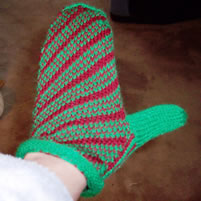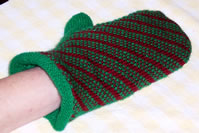
Machine Knit Mittens
 Knit January 1, 2005.
Knit January 1, 2005.This page has a pattern generator (aka program) to create a pattern to help you knit a mittens using a single knitting machine. I knit the one modeled on by my left hand unlined; the one on my right hand is lined. They are similar, but the lined one is warmer.
Mine were knit on a Passap , but you can knit these or similar mittens on any double bed including a Studio, Bond or Artisan easily. You can knit them using the yarn of your choice.
The hand knit version of the pattern, knit on on double pointed needles will eventually be available; click here.

Main site, blog, mitten collection, hat collection and poncho & cape collection.
Characteristics of the mittens:
- Knit from bottom up on a double bed machine.
- These have a small rolled hem. (This avoids rehanging the ribbing.)
- You can knit make lined or unlined mittens.
- You can knit the outside in fair-isle, or plain. (You must pick and program your own pattern stitch.)
- You enter the stitch and row gauge for your yarn.
- You must choose your own fair-isle pattern. Mine is a simple
pattern programmed into the Passap. If you are knitting unlined
mittens, I advise picking a design with very short floats. Otherwise,
the floats catch on rings and fingers. You can risk longer float
if you knit a lined mitten.
Skills and special equipment: You need a double bed machine and you
must know how to knit and cast on circular using your machine. If
you need mittens to knit on a single bed machine, visit the mitten collection.
Remember: Like all patterns spit out by my generators, this is
mostly shaping directions.
The purpose of the generators is to let you be
creative, while eliminating the need to do pesky
calculations.